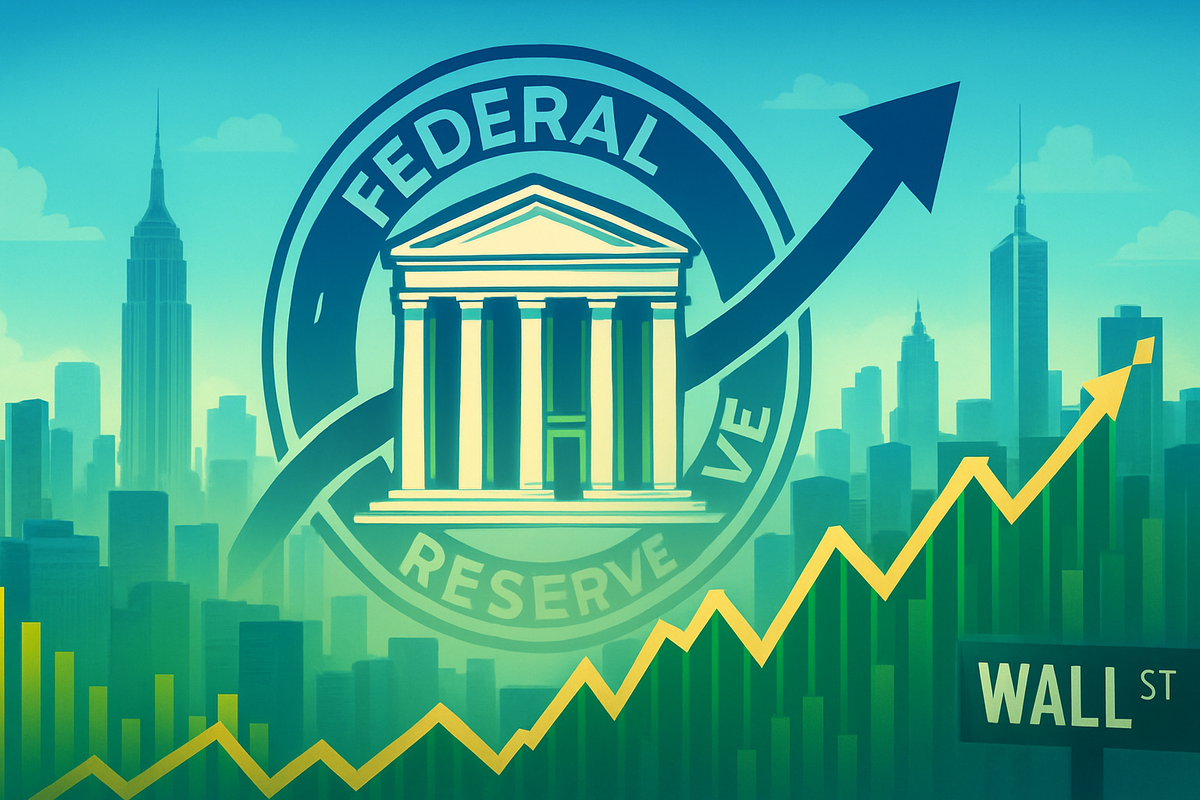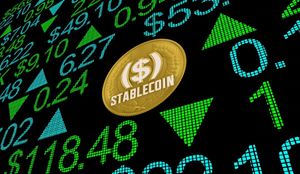
Wall Street is experiencing a significant surge on November 24, 2025, as investor confidence in an imminent interest rate cut by the US Federal Reserve reaches new heights. Bolstered by increasingly dovish signals from key Fed officials and a cooling economic landscape, market participants are now heavily pricing in a 25-basis-point reduction at the central bank's upcoming December meeting. This strong conviction in future Fed easing has ignited a broad-based rally across US equities, injecting a renewed sense of optimism and risk appetite into the financial markets.
The shift in sentiment is palpable, with the probability of a December rate cut now ranging from 70% to 85% according to CME Group's FedWatch Tool, a stark increase from just 30-42% a week prior. This dramatic recalibration of expectations is translating directly into market action, with major US stock indexes posting substantial gains as investors anticipate a more accommodative monetary policy environment. The current rally reflects a hopeful outlook that lower borrowing costs will stimulate economic activity and corporate earnings, providing a much-needed tailwind for growth-oriented assets.
Dovish Whispers and Market Roar: The Mechanics of the Current Rally
The recent pivot in market sentiment can be largely attributed to a series of "dovish" remarks from influential Federal Reserve officials, notably Governor Christopher Waller and New York Fed President John Williams. Their statements have underscored the potential for a "further adjustment" to interest rates in the near term, citing progress in slowing inflation and a gradually cooling labor market. These comments, coupled with the Fed's existing "modestly restrictive" policy stance, have been interpreted by many on Wall Street as a clear signal that the central bank is preparing to ease its monetary grip.
This intensifying anticipation of a December rate cut has had an immediate and profound impact across various asset classes. On November 24, all of Wall Street's main indexes—the Dow Jones Industrial Average (DJIA), S&P 500 (SPX), and Nasdaq Composite (IXIC)—experienced substantial gains, extending a rebound that began last Friday. Technology stocks and mega-cap companies, particularly those in the artificial intelligence (AI) sector such as Alphabet (NASDAQ: GOOGL) and Tesla (NASDAQ: TSLA), were at the forefront of this rally. The Nasdaq Composite, which had faced a volatile November, saw a particularly strong resurgence, with the communication services sector leading the charge. Analysts have described this movement as a powerful combination of "rate-cut enthusiasm" and the "fear of missing out" (FOMO) on potential gains.
The dovish pronouncements from Fed officials provided a crucial reprieve, effectively halting a month-long sell-off in US stocks that was partly fueled by concerns over AI sector valuations and the economic fallout from a recent US government shutdown. While the S&P 500 and Nasdaq are still on track for monthly losses in November, marking their steepest declines since March, Monday's rally offers a significant reversal. Beyond equities, the bond market also reacted swiftly, with US Treasury yields, including the benchmark 10-year yield, cooling and dipping to their lowest in three weeks, reflecting renewed confidence in a potential Fed pivot. The CBOE Volatility Index (VIX), often seen as the market's "fear gauge," tumbled significantly, signaling calmer market conditions and a rotation away from defensive hedges. Gold prices either steadied or pushed higher, supported by declining Treasury yields, while the US Dollar Index edged slightly lower, weighed down by the increased speculation of rate cuts. Despite the current euphoria, some policymakers have expressed caution, highlighting existing divisions within the central bank ahead of the crucial Federal Open Market Committee (FOMC) meeting on December 10. Investors now eagerly await upcoming economic data, including September retail sales and producer prices, which were delayed by the government shutdown, as these releases will be critical in providing further clarity for the Fed's decision-making process. The "dominant theme of uncertainty" is expected to persist until the FOMC meeting concludes.
Companies Poised to Thrive or Struggle Amidst Rate Cut Expectations
The prospect of lower interest rates in late 2025 is setting the stage for a significant reallocation of capital, creating clear winners and some potential areas of reduced benefit across the corporate landscape. Sectors sensitive to borrowing costs and consumer spending are particularly poised for a boost.
The Home Construction and Real Estate sectors are among the most direct beneficiaries. Lower mortgage rates directly translate to increased affordability, stimulating buyer demand and unlocking the housing market. Homebuilders, construction material suppliers like Builders FirstSource (NYSE: BLDR), and flooring providers such as Mohawk Industries (NYSE: MHK) are expected to see a significant uptick in activity. Real Estate Investment Trusts (REITs) and multifamily real estate investors could also capitalize on refinancing opportunities, portfolio expansion, and rising property valuations driven by increased market liquidity. Small-Cap Companies, often more reliant on debt for growth, stand to gain substantially from reduced borrowing costs, which can enhance profitability and expand investment capacity. The Russell 2000 index, representing these smaller firms, typically outperforms in such environments.
The Financials sector presents a nuanced but largely positive outlook. While a rapid flattening of the yield curve could compress net interest margins for some banks, the overall expectation is for increased loan demand across consumer and commercial segments, coupled with stimulated capital markets activity. Investment banks like Goldman Sachs (NYSE: GS) could see higher fees from a more active M&A and capital-raising environment, while regional banks are likely to benefit from increased personal and commercial loan origination. Industrials, with their capital-intensive projects, will find financing more affordable, spurring infrastructure development and industrial activity. Companies such as Caterpillar (NYSE: CAT), a major construction equipment manufacturer, are well-positioned to benefit from increased capital expenditure projects.
Consumer Discretionary companies are also set to thrive as lower rates alleviate financial pressure on households, freeing up disposable income for non-essential goods and services. This could lead to a rebound in big-ticket purchases that were deferred during periods of higher rates. Retailers like Ross Stores (NASDAQ: ROST), which reported strong earnings in Q3 2025, could see continued robust performance. The Technology and Communication Services sectors, particularly growth-oriented firms, often rely on debt to fund innovation and expansion. Cheaper financing will support their growth trajectories, especially those heavily invested in Artificial Intelligence (AI) infrastructure and development. Companies like Alphabet (NASDAQ: GOOGL), benefiting from its Gemini 3 AI model launch, and semiconductor giants such as Broadcom (NASDAQ: AVGO) and Western Digital (NASDAQ: WDC), are expected to continue their strong performance. Furthermore, Utilities, often viewed as bond proxies, become more attractive with declining rates and benefit from lower borrowing costs due to their leveraged operations. Companies with significant outstanding debt will also find opportunities to refinance at lower rates, improving their balance sheets and profitability, while cheaper financing will likely invigorate the M&A market.
Conversely, Savers and Fixed-Income Investors are likely to experience reduced returns on cash deposits and many fixed-income investments as interest rates fall, impacting those who rely on interest income from savings accounts or Certificates of Deposit (CDs). While the broader financial sector is set to benefit, certain banks could face challenges if the yield curve flattens significantly, compressing their net interest margins. However, this is seen as a secondary concern compared to the overall positive impact of increased lending and market activity.
Wider Economic and Market Implications of Fed Easing
The potential interest rate cuts by the US Federal Reserve in late 2025 carry profound wider significance, extending beyond immediate market reactions to influence broad economic trends, global financial dynamics, and regulatory considerations. This anticipated shift in monetary policy is a strategic move to stimulate economic growth and maintain a robust labor market amidst evolving global conditions.
From a broader industry perspective, cheaper borrowing costs are expected to invigorate corporate investment, spurring businesses to embark on new ventures, expand operations, and invest in capital projects and innovation. This environment is also conducive to increased mergers and acquisitions (M&A) activity, as financing becomes more accessible and affordable. Firms with strong balance sheets capable of refinancing existing debt at lower rates will gain a significant competitive advantage. For consumers, reduced interest rates translate to cheaper credit for mortgages, auto loans, and potentially credit cards, making big-ticket purchases more attainable and boosting overall consumer confidence and spending. However, this comes at the expense of savers, who will likely see lower returns on interest-bearing accounts, potentially prompting them to seek higher-yielding alternative investments. Sector-specific impacts will be notable: the real estate market is set to flourish with more affordable mortgages, technology and manufacturing companies could see increased sales and output due to reduced financing rates, and the stock market, historically, often rallies during rate-cutting cycles, benefiting from lower discount rates for future cash flows. Conversely, bank deposit rates are likely to decrease.
The ripple effects of the Fed's easing will be felt globally. A weakening U.S. dollar, a common outcome of rate cuts, makes American exports more competitive internationally, benefiting US-based companies. This can also attract capital flows to emerging markets, easing their external debt burdens if denominated in US dollars, though it could also introduce increased volatility. The Fed's actions often serve as a bellwether for other central banks, potentially influencing them to consider similar rate adjustments to maintain competitive exchange rates and prevent capital outflows. For instance, the European Central Bank has already initiated policy rate cuts this year, indicating a potential coordinated effort among developed nations to foster growth. Within the competitive landscape, firms that can refinance debt cheaply will gain an edge, potentially leading to further industry consolidation and M&A activity. The performance of market leaders, particularly in the technology sector, will continue to have significant cascading effects on their competitors, partners, and suppliers.
From a regulatory and policy standpoint, the Fed's easing will necessitate increased vigilance from regulators. There will likely be heightened monitoring for potential asset bubbles, especially in real estate and equity markets, as abundant cheap money can encourage increased risk-taking. Scrutiny of lending standards may also intensify to prevent a build-up of systemic risk. While rate cuts aim to stimulate growth, concerns about inflation persistence above the Fed's 2% target remain, meaning extended periods of monetary accommodation could reignite inflationary pressures. The Fed's communication strategy, which has evolved to provide enhanced transparency, will be crucial in managing market expectations and reducing uncertainty. Furthermore, the interplay between the Fed's monetary policy and government fiscal policy (e.g., spending, taxation, and potential new trade policies like tariffs) will continue to influence economic growth and inflation, adding another layer of complexity.
Historically, the Fed typically implements rate cuts in response to economic slowdowns or recessions, as seen during the early 2000s recession and the 2007-2008 financial crisis. These cycles have varied in magnitude and duration; for example, the 2007-2008 crisis saw a 5.25 percentage point reduction over 15 months. Generally, lower rates aim to boost spending and support economic growth, with real consumer spending often rising during and after such periods. Inflation, after an initial decline, has historically tended to pick up again about a year after the final rate cut. Stock markets often rally during rate cut periods, especially when the cuts are in response to economic "soft patches" rather than full-blown recessions, while bond prices tend to rise. Out of ten previous rate cut cycles, only two avoided a recession, and the current 2024-2025 cycle could mark the third if a recession is successfully averted. Forecasts from institutions like J.P. Morgan and Goldman Sachs anticipate further rate cuts in 2025, potentially bringing the federal funds rate to around 4%, against a backdrop of continued but slower economic growth, unemployment slightly above 4%, and inflation hovering around 2.5%, still above the Fed's target. A "widespread deceleration" in the global economy in 2025, influenced by new U.S. trade policies, could further prompt the Fed to act to support growth.
The Path Ahead: Short-Term Gains, Long-Term Vigilance
The anticipated rate cuts by the US Federal Reserve in late 2025 mark a pivotal shift towards economic support, aiming for a "soft landing" amidst a cooling labor market and easing inflation. This easing cycle, expected to extend intermittently through 2026 and 2027, presents a complex landscape of short-term opportunities and long-term challenges for both consumers and businesses.
In the short term (late 2025 - mid 2026), consumers can anticipate reduced borrowing costs across various credit products, including credit cards, auto loans, and home equity lines of credit (HELOCs), potentially leading to increased disposable income and spending. Mortgage rates may also see a decline, enhancing housing affordability. However, savers will likely face diminished returns on their deposits. For businesses, lower borrowing costs will encourage investment, expansion, and hiring, improving profitability and balance sheet health, particularly for those able to refinance existing debt. The stock market is generally expected to react positively, with growth-oriented sectors like technology and small-cap stocks receiving a tailwind. Short-term Treasury yields are projected to fall, increasing the price of existing bonds, with a preference for the "belly" of the curve (3-7 year duration). While the Fed aims to stimulate the economy, a delicate balance must be maintained to prevent a resurgence of inflation, which might see a temporary uptick due to factors like tariffs before resuming its downward trend. A weaker US dollar is also a likely outcome, making US exports more competitive.
Looking further into the long term (mid 2026 and beyond), the success of the Fed's "soft landing" strategy will dictate the sustainability of economic growth, which is forecast to remain below the historical 2% trend. Inflation is expected to tick up through 2026, partly due to tariffs, but then is projected to fall back in 2027, potentially converging to the 2% target by 2027-2031. A prolonged period of lower interest rates could, however, encourage excessive risk-taking, potentially leading to asset bubbles in markets such as stocks and real estate. Forecasts suggest the 10-year Treasury yield could average around 3.25% by 2028, and the 30-year mortgage rate could fall to approximately 5.00% by the same year.
To navigate this evolving environment, strategic pivots and adaptations will be crucial. For businesses, this means capitalizing on lower borrowing costs by refinancing debt, reinvesting in operations, technology, and growth initiatives, and exploring expansion and diversification opportunities. Maintaining operational efficiency, strong customer relationships, and aligning inventory and pricing with economic cycles will also be key. Investors, on the other hand, should consider reallocating portfolios away from high cash allocations into targeted bonds, particularly in the short-to-intermediate duration. Diversification, including international equities, digital assets, and alternatives, can help manage volatility, while carefully selected equity exposure in quality large-cap, growth, technology, and small-cap stocks, as well as sectors like housing and commodities, may offer opportunities. Fixed income options such as municipal bonds and hybrid instruments could provide tax-advantaged income and equity-like upside. Given potential market volatility and ongoing uncertainties, an agile approach with active management and sector-specific insights will be paramount, with gold potentially remaining an attractive safe-haven asset.
The emerging market opportunities include increased liquidity driving investment and consumer activity, attractive borrowing costs spurring expansion, strong equity market performance in non-recessionary cutting cycles, appreciation in fixed income assets, potential capital inflows into emerging markets, and a boost in M&A activity. However, significant challenges loom, such as the risk of renewed inflationary pressures (potentially fueled by tariffs and increased demand), the possibility of a deeper economic slowdown leading to a "hard landing" (recession), the formation of asset bubbles due to prolonged low rates, reduced returns for savers, persistent market volatility, and increased credit risk if corporate earnings decline.
Navigating the Easing Cycle: A MarketMinute Wrap-Up
As November 24, 2025, draws to a close, the US Federal Reserve stands at a critical juncture, having initiated an easing cycle that is now widely expected to include a further interest rate cut in December. This pivot towards accommodative monetary policy is a response to a cooling labor market and moderating inflation, aiming for a delicate "soft landing" for the economy.
Key Takeaways: The Fed has already implemented several rate reductions throughout 2024 and 2025, bringing the federal funds rate to a target range of 3.75%-4.00% by October. While dovish remarks from officials like Governor Christopher Waller and New York Fed President John Williams have fueled market expectations for further easing, internal divisions persist, with some policymakers expressing caution regarding persistent inflation. A "data vacuum" caused by a recent government shutdown has further complicated the Fed's decision-making process. Notably, the Fed's decision to conclude Quantitative Tightening (QT) by December 1, 2025, will inject additional liquidity into the financial system.
Market Assessment Moving Forward: Financial markets are pricing in a high probability (65%-75.1%) of another 25-basis-point cut at the December FOMC meeting. This expectation has sparked bullish sentiment, particularly in technology and growth stocks, and has contributed to easing Treasury yields. Investors are largely anticipating a scenario of continued economic growth under less restrictive monetary conditions.
Significance and Lasting Impact: The Fed's evolving stance reflects its ongoing struggle to balance its dual mandate of maximum employment and price stability. The success of this easing cycle hinges on achieving a "soft landing" – bringing inflation down without triggering a recession. The conclusion of QT will provide additional liquidity, potentially supporting asset prices and financing conditions, contributing to overall economic stability. The lasting impact will be measured by the Fed's ability to navigate these complexities and guide the economy to sustainable, non-inflationary growth.
What Investors Should Watch For in Coming Months: Vigilance will be paramount for investors. Closely monitor incoming inflation data, particularly Personal Consumption Expenditures (PCE) and Core PCE reports, for signs of sustained deceleration. Pay keen attention to labor market indicators such as nonfarm payrolls, unemployment rates (which ticked up to 4.4% in September), and wage growth, as these are critical to the Fed's data-dependent approach. Heed the statements from Federal Reserve officials, noting the nuanced and sometimes divergent views that offer insights into potential policy shifts. Observe Treasury yields, as their movements often reflect changing expectations for rate cuts. Finally, continue to assess corporate earnings, especially as the strong performance of S&P 500 companies in Q3 2025 has provided crucial market support. In this dynamic environment, maintaining a diversified portfolio and employing robust risk management strategies will be essential.
This content is intended for informational purposes only and is not financial advice






